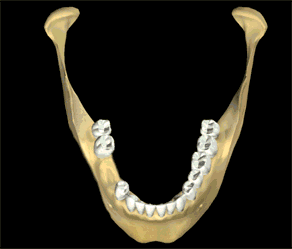Bone Grafting
Over a period of time, the jaw bone associated with missing teeth atrophies or is resorbed. This often leaves a condition in which there is poor quality and quantity of bone suitable for placement of dental implants. In these situations, most patients are not candidates for placement of dental implants.

We now have the ability to grow bone where needed. This not only gives us the opportunity to place implants of proper length and width, it also gives us a chance to restore functionality and esthetic appearance. The bone graft procedures are referred to as:
Sinus lift procedure
This procedure involves elevating the sinus membrane and placing the bone graft onto the sinus floor, allowing implants to be placed in the back part of the upper jaw
Ridge augmentation
In severe cases the ridge has been resorbed and a bone graft is placed to increase the ridge height and/or width.
Nerve- repositioning
The inferior alveolar nerve, which gives feeling to the lower lip and chin, may need to be moved in order to make room for placement of dental implants to the lower jaw.
These procedures may be performed separately or together, depending upon the individuals condition. There are several areas of the body which are suitable for obtaining bone grafts. In the maxillofacial region, bone grafts can be taken from inside the mouth, in the area of the chin or third molar region or in the upper jaw behind the last tooth. In more extensive situations, a greater quantity of bone can be attained from the hip or the outer aspect of the tibia or shin-bone below the knee.
These surgeries are performed in our office surgical suite under I.V. sedation or general anesthesia. After discharge, bed rest is recommended for one day and limited physical activity for one week.
